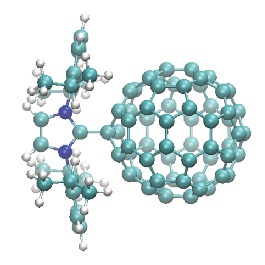Electron states and dynamics : new developments in molecular theory and integration of heat fluctuations
Interviewee:
|
Interviewer:
|
| Professor, Graduate School of System Informatics, Kobe University |
CMSI Molecular Science |
Overview of the Research Topic
Yonehara: The aim of theoretical molecular science is to predict, understand and eventually control real-world chemical phenomena. In this field, two things are extremely important: (1) determining whether theories can be applied to molecular systems and material systems of a realistic size, and (2) developing calculation methods that are easy to use and capable of making highly accurate predictions. The theoretical side has universal significance in the sense that it provides
reliable reference data for experimentation. In the theoretical materials science, which is based primarily on electron states, electron
correlation which defines the many-body correlations among electrons holds the key to quantitative predictions. First, could you tell us a little about this Priority Research Topic?
Ten-no: The objective of this Priority Research Topic is to challenge problems that can only be solved using the K computer, and to achieve major research achievements that have significance for society as well. The code for electron state calculations for molecules
that use Gaussian basis functions is extraordinarily complex, and even for someone well-versed in the use of the K computer, a variety of techniques are required. Currently F12 theory massively parallel modules have been provided, and production runs for nanocarbon materials and so on are being conducted. Throughout the latter half of the mission, it will be essential to make it possible to conduct material design that includes excited states in organic electroluminescence (EL) and artificial photosynthesis, and to search for materials that can substitute for rare earths, and thereby to produce a flow of scientific
knowledge to other research groups.
Yonehara: How did this topic come to be established for the Priority Research Topic?
Ten-no: Up to now, the main method that has been used in materials design and other application fields is the density-functional approach. However, there are many drawbacks in this approach from the theoretical point of view. Our motivation was that, by making it possible to run the perturbation theory and coupled cluster theory that have been developed in the molecular science field on the K computer, we might achieve a material science that is fundamentally different from the one that we have known up to now.
 |
F12 calculation of IDipp-C₆₀. Collaboration with Prof. Shigeru Nagase at Fukui Institute for Fundamental Chemistry. |
Research outcome and future prospects
Yonehara: Could you tell us about some specific recent achievements?
Ten-no: The molecular quadrature method used in the F12 method is well suited to massively parallel computing, and up to now we have pursued hybrid parallelization. This has made it possible to achieve extremely high execution efficiency even with several hundred thousand CPU cores. In addition, the execution efficiency of the integration that is needed for molecular orbital calculation was a bottleneck, but here as well, we converted the code that used the quadrature method to SIMD and thereby managed to develop it into a useful calculation method.
Yonehara: In addition to accurate knowledge of molecular structures including electron states, chemistry often requires microscopic information on reaction dynamics. Could you talk about the possibility of applying your own research techniques to reaction dynamics, and
the issues that might arise in such cases and how you imagine they might be resolved?
Ten-no: With regard to low-lying excited states, careful calculation of the matrix elements for nonadiabatic coupling with the potential surface generally makes it possible to determine what is happening. You need reaction dynamics in order to quantify things to the point where it's almost as if you've seen what happened with your own eyes.
But in general the interesting phenomenon is the multiple degree of freedom dynamics, so I don't think this can be separated from the electron state calculations. I hope that one day techniques for dynamics will develop to the point where they can be incorporated into electron state theory.
Appeal of computational materials science
Yonehara: Finally, could you speak directly to the younger generation (university students and graduate students) about the appeal of molecular science and computational materials science, and about the usefulness of computers in scientific research?
Ten-no: I think the fascinating aspect of this area of research is that theoretical calculations are able to predict real-world materials science, and that a bottom-up approach is used to achieve this. For many years, I've felt that developing basic theory offers a better chance of producing major breakthroughs than the use of large computers. Nevertheless, considering the scale of the massively parallel computing environments in recent years, I think that supercomputers are getting to the point where they provide a major advantage for conducting scientific and engineering calculations. I think combining the K computer with the highly precise quantum chemistry theory that has been developed in the field of molecular science will, in the future, reveal essential truths about materials science that we have not been able to see up to now.



